Finishing top of their qualifying group with just one loss, Belgium have reached the UEFA Women’s European Championship for just the second time ever. After first qualifying for the tournament in 2017 and failing to reach the knockout stage, Belgium are set to encounter another challenging group in 2022. Currently 20th in the world rankings, the Red Flames are ranked behind group stage opponents France (3rd), Italy (14th), and Iceland (18th). With limited tournament experience alongside a difficult group, many will be expecting little from Belgium.
However, Ives Serneels’ team are entering the tournament with great confidence. Coming off the back of success in the 2022 Pinatar Cup, in which they were victorious in two penalty shootouts, they showed elements of what is required to win in knockout competition. Also chasing World Cup qualification for the first time ever, Belgium have scored 49 goals as they relentlessly pursue group-leaders Norway with two games remaining. This frightening goal-scoring ability will undeniably intimidate their group-stage opponents, so maybe the Belgian Red Flames could progress into the knockouts.
Predicted Starting XI
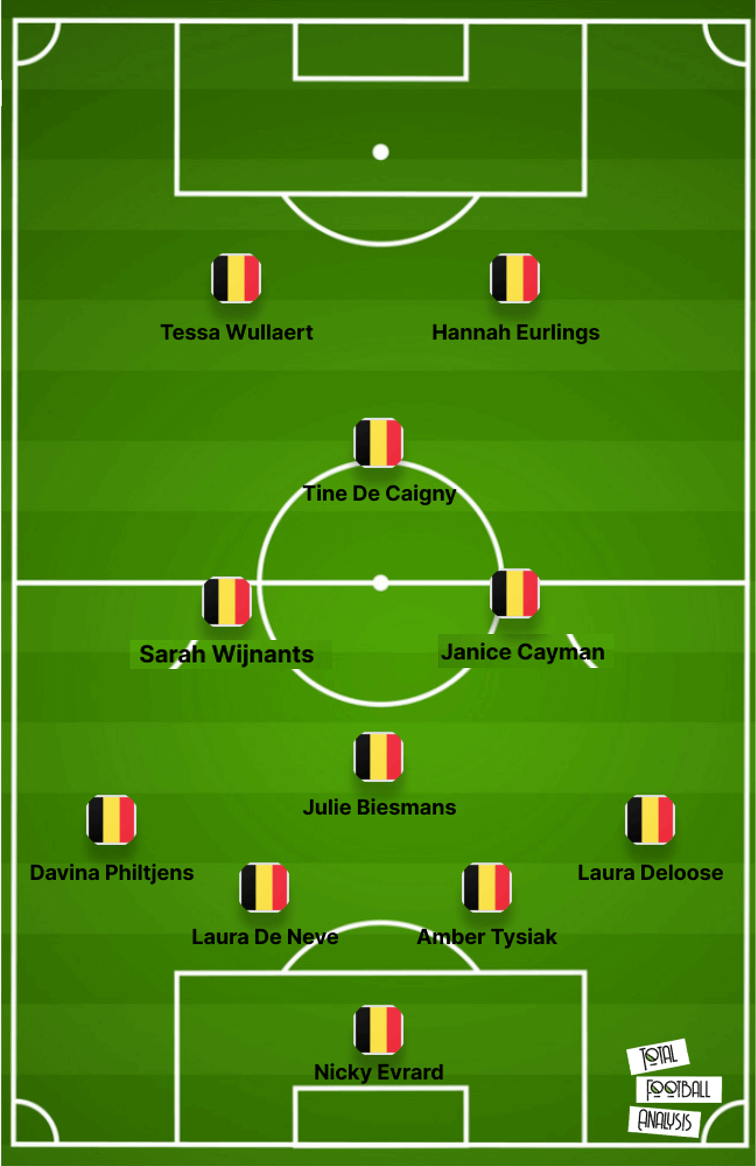
Under Ives Serneels, Belgium have commonly deployed a 4-1-2-1-2 — although, sometimes, they may set up in a 4-3-3. Gent’s Nicky Evrard will start between the sticks for the Red Flames with a centre-back pairing of Laura De Neve and Amber Tysiak in front of her. After missing the last international break, Tysiak will partner De Neve to form a balanced, defensively strong yet positive in-possession pairing. It’s expected that the back four will be completed with the experience of right-back Laura Deloose and left-back Davina Philtjens, who has over 100 caps for Belgium.
The Belgian midfield and forward selections are stacked with versatility; some holding midfielders have covered at centre-back, while some forwards have dropped back to play a midfield role, for example. Janice Cayman, the nation’s most capped player ever, epitomises their versatility. Expected to play on the right of their midfield diamond, Lyon’s Cayman has also appeared at right-back and in the forward line. One of Belgium’s top assisters in Sarah Wijnants is expected to play on the opposite flank, with her tidy footwork and movement from the wing always a threat to opponents.
Behind all their attacking talent, Belgium need a holding midfielder capable of regaining and recycling possession. Despite Reading’s Justine Vanhaevermaet’s impressive performances and superior ball-winning ability, we have selected PSV’s Julie Biesmans. However, both players are capable starters to fulfil the role, with OH Leuven’s Lenie Onzia always an option off the bench. All these players have been deployed at centre-back too, with Biesmans also recently playing as a left midfielder.
Tine De Caigny of Hoffenheim regularly supports the striker pairing from attacking midfield, looking to break into the box and overload centre-backs. Not always offering defensive influence, her attacking output definitely justifies her inclusion in the starting XI. Ahead of De Caigny will likely be Hannah Eurlings and key player Tessa Wullaert. Wullaert is Belgium’s record goalscorer, and for her country this season is averaging a goal involvement every 30 minutes! Despite being without Wullaert’s goal-scoring record, Eurlings is crucial to Belgium due to her movement in behind constantly testing opposition defences.
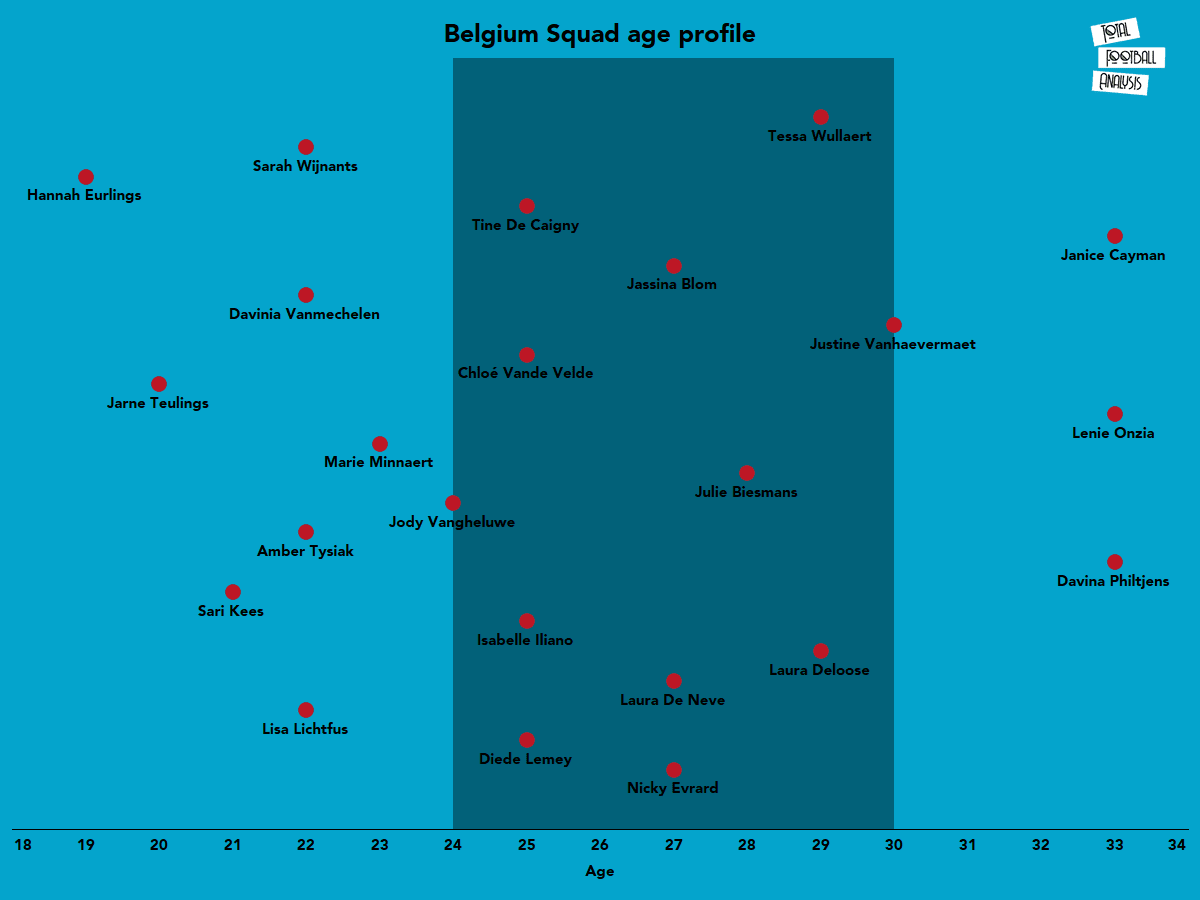
Attacking Phase
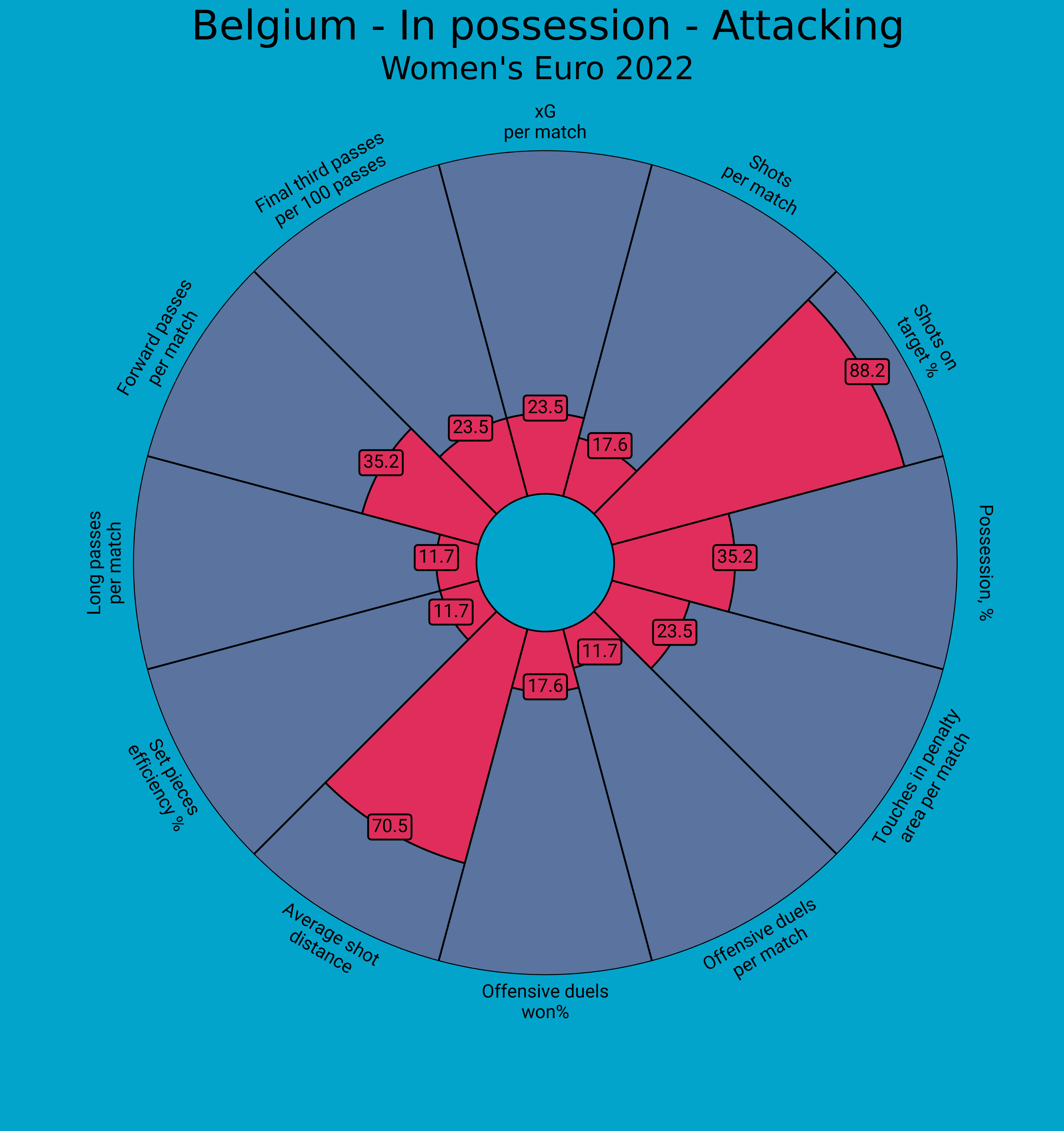
Serneels is capable of employing a bold, attacking-heavy approach to overload opposition defences. Usually set up in a 2-3-5 in possession, the five players positioned in the front line can cause havoc to opposition defences, leading to Belgium’s stellar goal-scoring numbers. Recently, Belgium’s 4-1-2-1-2 on paper transitions into the front five with the attacking midfielder and two wide players joining the striker partnership.
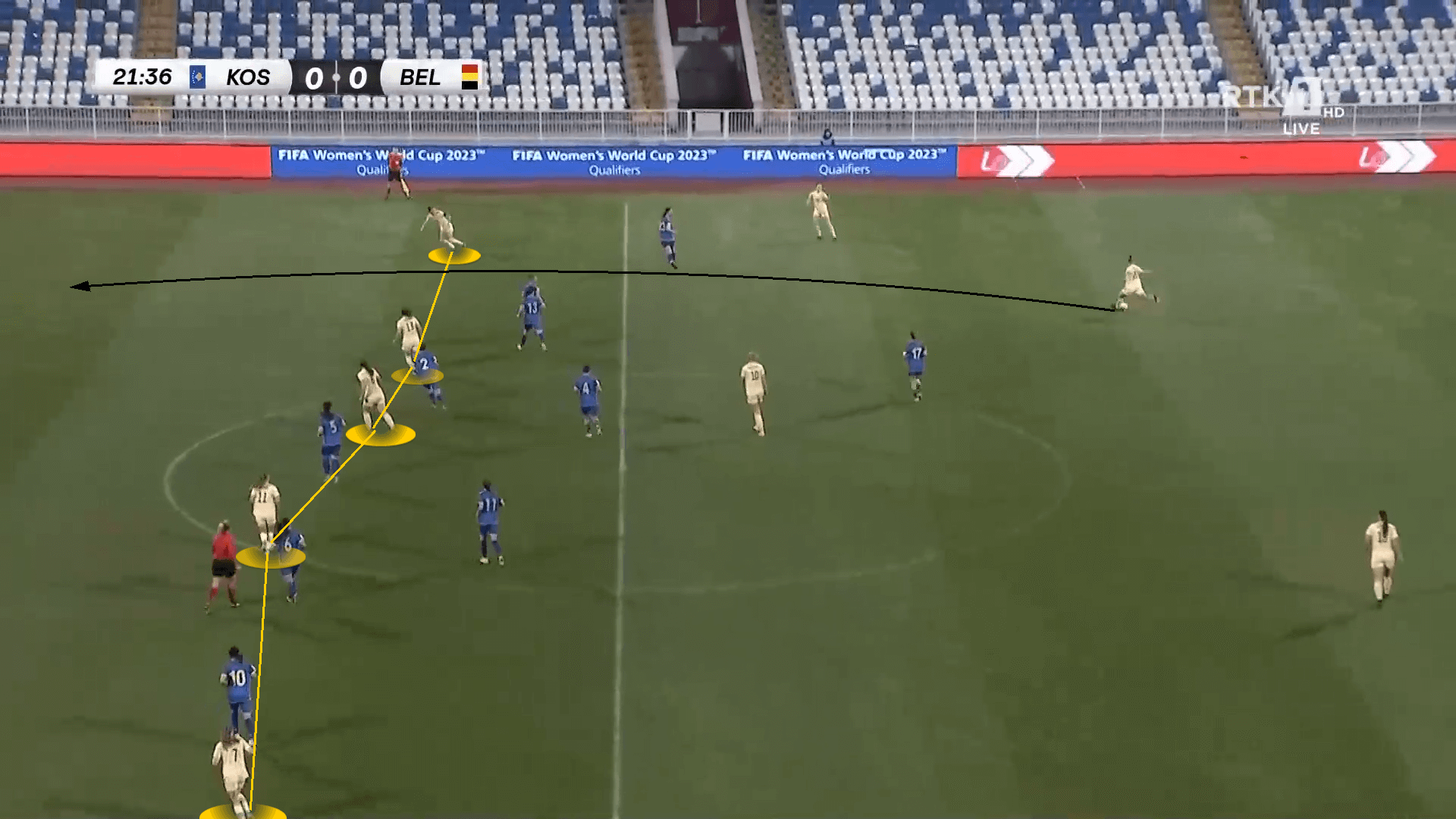
Here is an example of Belgium operating with a front five to successfully overload Kosovo. Despite having every player behind the ball, the overload has perturbed the Kosovan defensive structure and allowed Belgium to penetrate in behind on the right-wing via a centre-back’s through ball. It is common for Belgium to attempt through balls due to their forward’s tendencies to sit on the shoulder of the defender to run in behind. Often, the strikers will start in an offside position before dropping back onside to perfectly time their run in behind. This strategy can lead to lots of offsides, but correct timing of runs from Eurlings and Wullaert particularly creates clear-cut chances.
Belgium’s front five also allows them to commit numbers into the box with possession in the final third. Generally attacking the box from wide areas, Belgium can bring their strike partnership, attacking midfielder, and far-side winger into the box to attack crosses. With full-backs permitted to advance in some games, the number can rise to five players inside the box to trouble opposition defences. This occurs more frequently on the left-wing, with the left-winger inverting so left-back Philtjens can overlap or be the width provider.
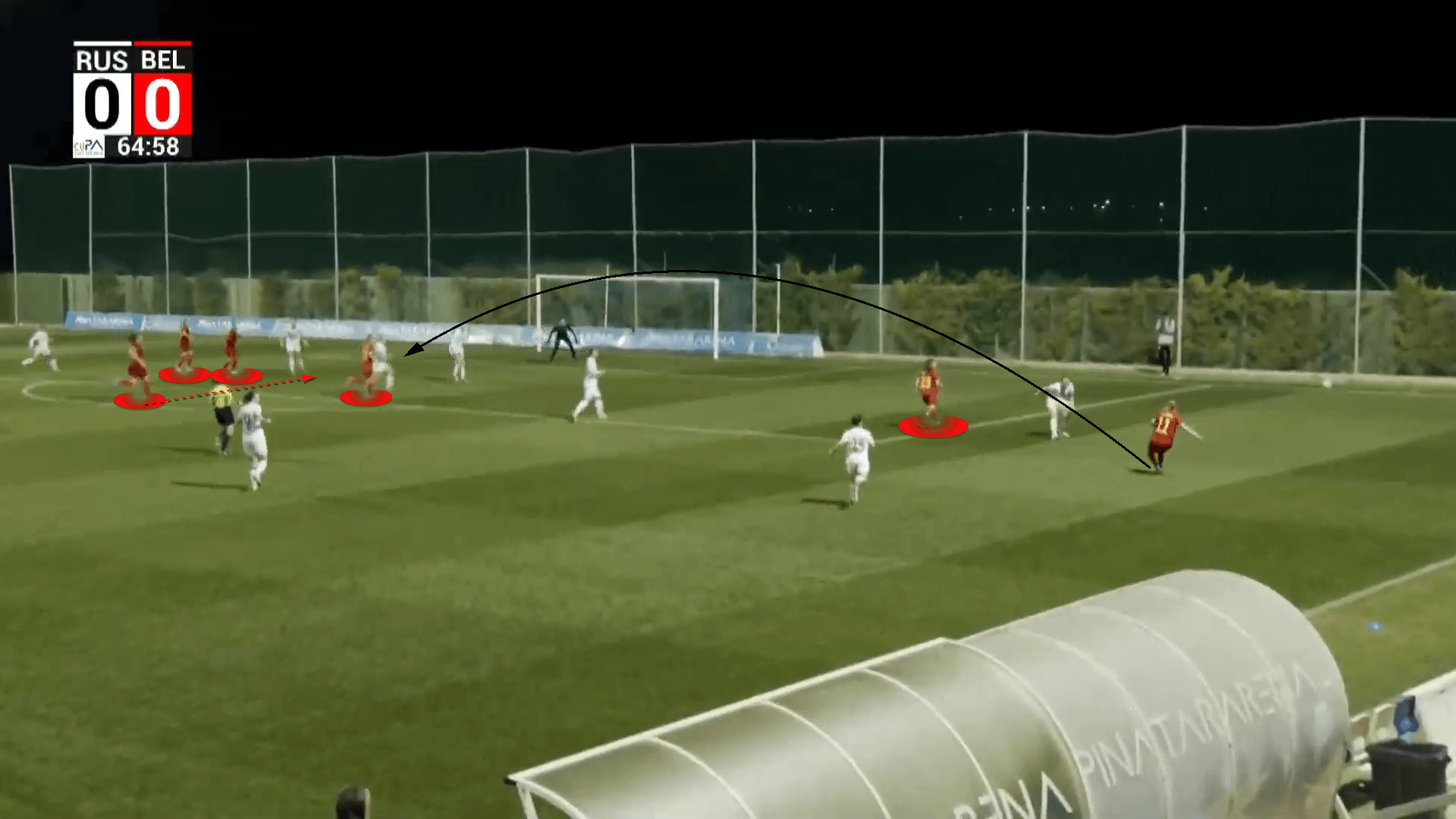
Although the front five can cause issues for opposition defences, their lack of help in build-up and ball progression can hinder Belgium. This relies on the holding midfielder, centre-backs and full-backs to access the forward line. Typically, the full-backs will be used to find the wingers from deeper areas but overall, it’s the centre-backs that have the greatest influence. The holding midfielder is mainly an option for recycling possession and changing the point of attack from one wing to the other but rarely attempts probing passes. Their movement is often away from the centre-back in possession to create space for them.
The centre-backs are assertive with their first touch, looking to carry the ball forwards into the final third when given space. They rarely attempt cross-field diagonals but the centre-backs are accurate and dangerous with their passes into the half-space and behind defences, a bonus to positioning centre-backs on the side of their strongest foot.
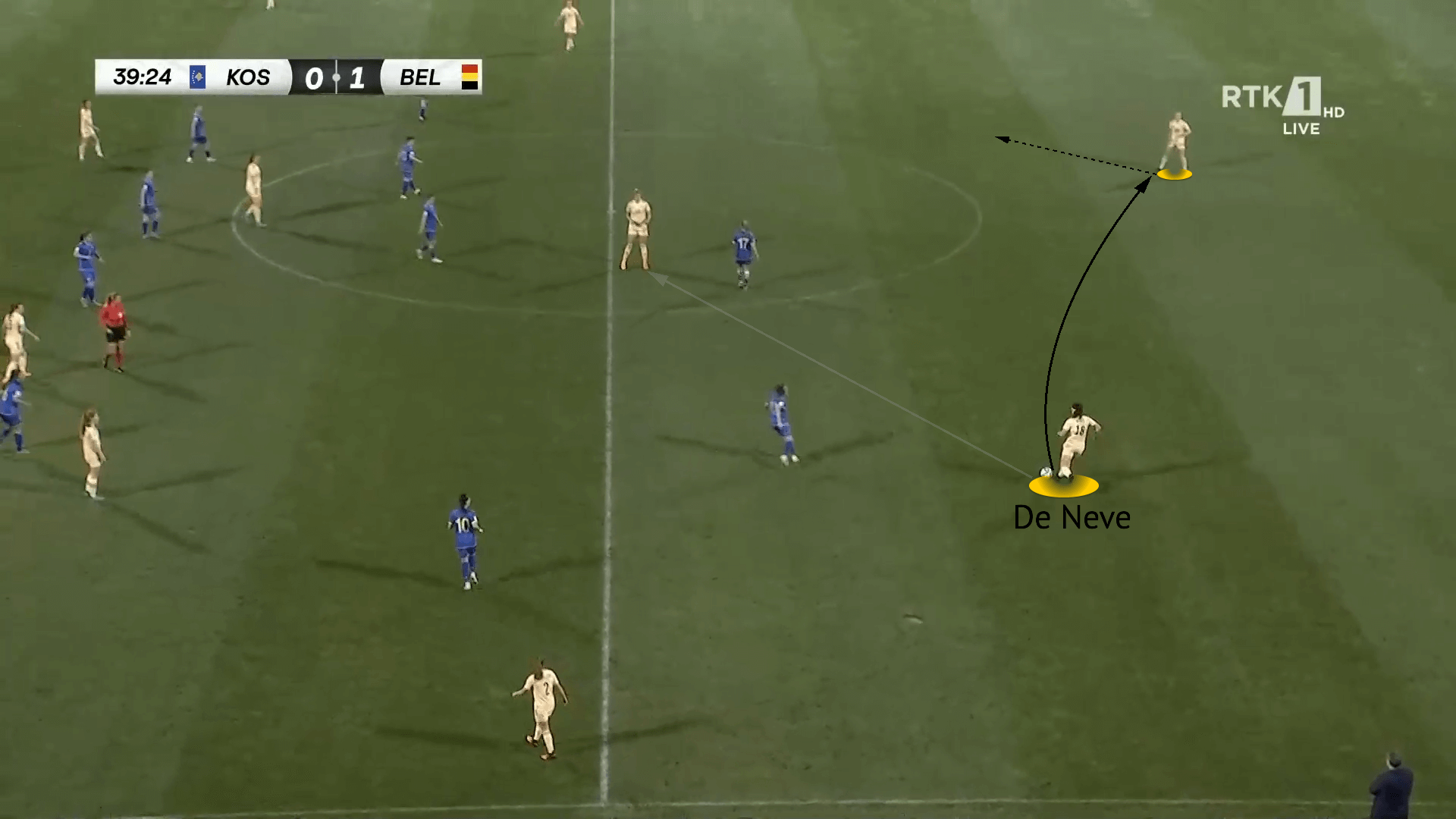
The attacking midfielder, usually Tine De Caigny, is positioned in the front five and tends to stay there, floating between the lines, not dropping back to receive in build-up. When Belgium deploy a 4-3-3 formation, they continue to adopt the 2-3-5 in possession by pushing the two central midfielders into the half-spaces of the front five. However, whilst the central midfielders are initially occupying spaces in the front five, they drop off to become passing options to receive off the centre-backs significantly more than De Caigny as an attacking midfielder. The 4-3-3, Serneels’ alternative formation, has been used against stronger opposition and in tighter games to provide more defensive solidity with an adjustment of the central midfielders’ positioning into deeper areas rather than in the front five.
Defensive Phase
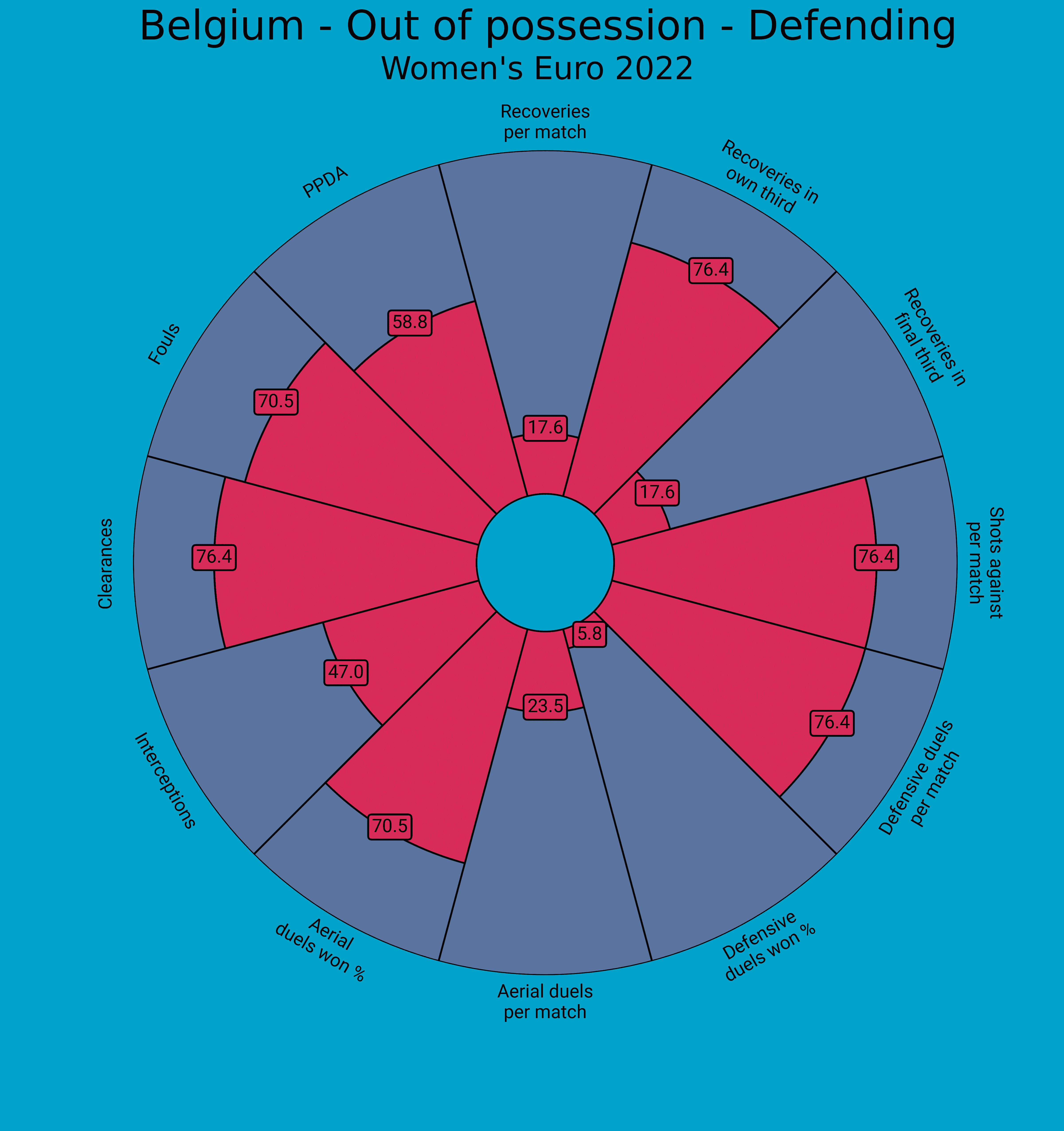
Ordinarily, Belgium’s out-of-possession shape is a 4-1-3-2. This has similarities to their in-possession shape, with the holding midfielder essentially detached from the midfield unit. The shape also allows Serneels’ team to easily transition from in possession to out of possession, as the attacking and wide midfielders simply drop back.
From opposition goal kicks, Belgium set up in the 4-1-3-2, as shown below in the example against Albania. The strikers are responsible for pressing the opposition centre-backs, angling their press to force the ball wide to the full-back. The angle of the striker’s press must also keep the opposition pivot player in their cover shadow, positioned to easily intercept an attempted pass to them. Belgium’s wingers start fairly narrow, preventing central progression, with the centre-back’s pass into the full-back their trigger to press in-to-out. When the opposition deploy a single pivot, Belgium’s attacking midfielder tends to man-mark them. Whereas in the example below, the attacking midfielder is positioned between Albania’s double pivot.
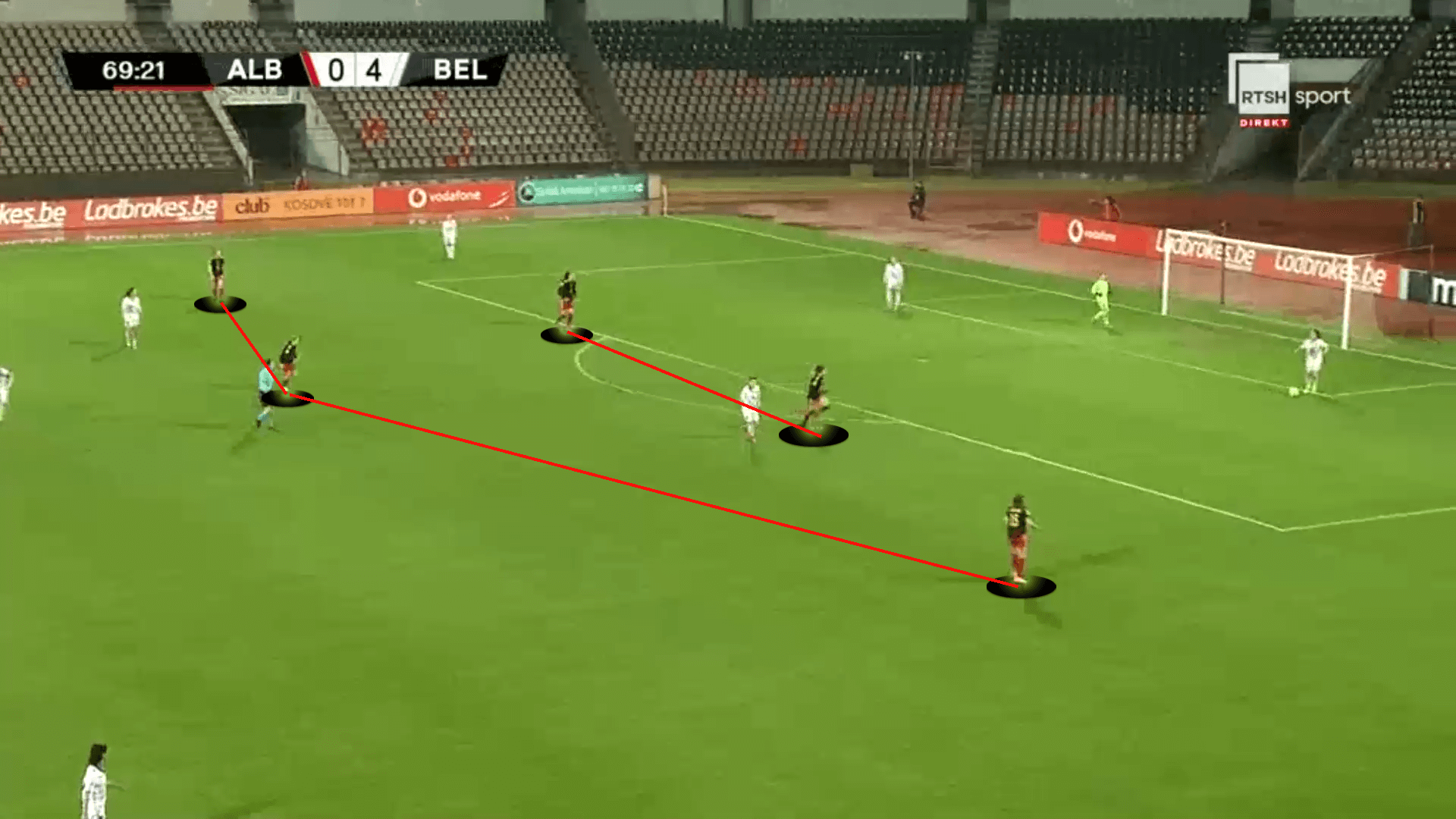
These same principles occur when the opposition are progressing from build-up to consolidated possession. The wingers are positioned narrower, more in the half-spaces, to solidify the central channel. As the opposition play the ball into the wide channel, the ball-side winger will shift across to press. Meanwhile, the far-side winger will drop in towards the holding midfielder to provide cover and balance.
The figure below is an example of this against Russia in the 2022 Pinatar Cup final. As the ball moves into the widest channel, the right-winger begins to move wider, with Belgium’s left-winger dropping deeper into the midfield.
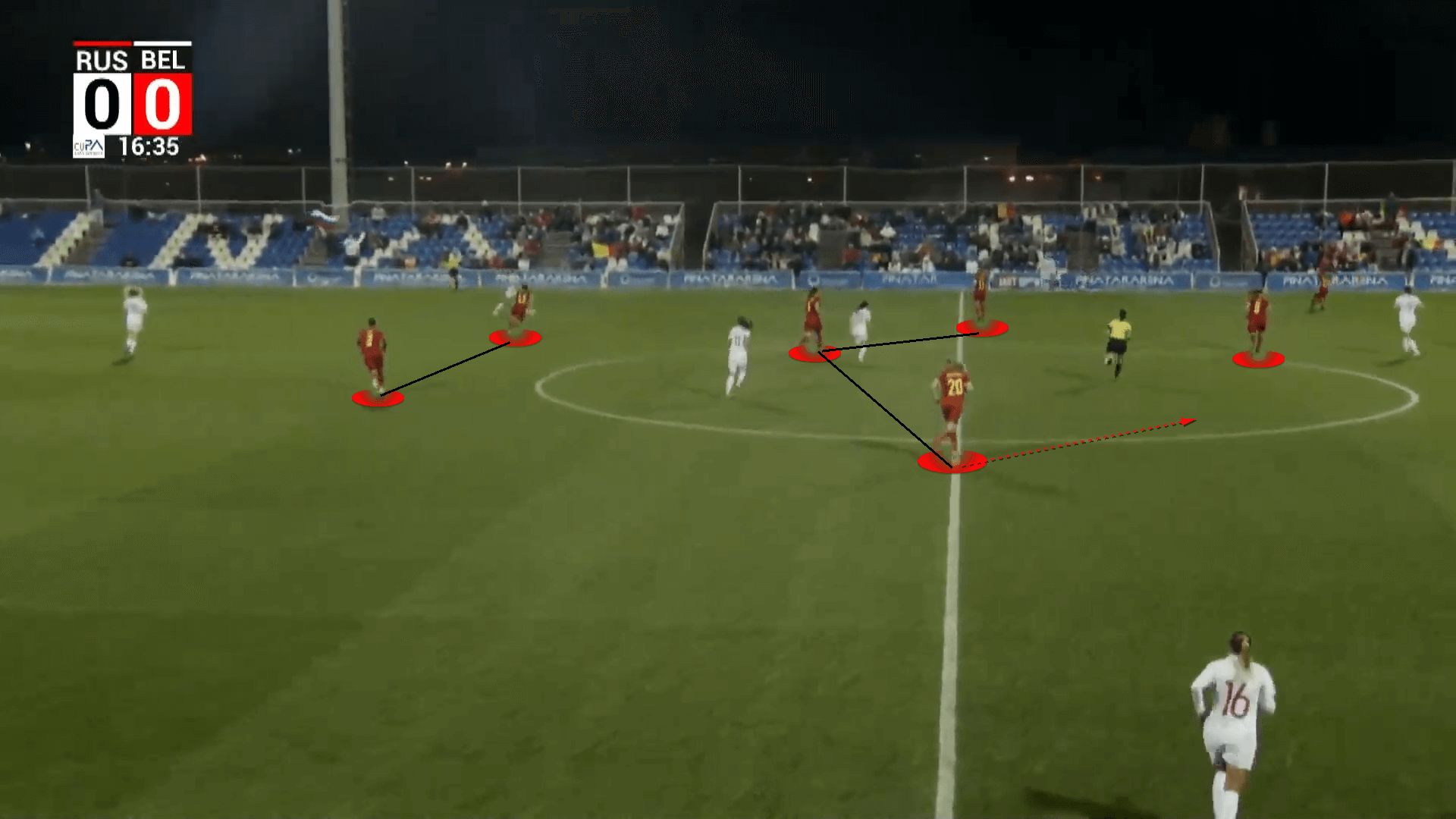
In the eleven international fixtures Belgium have played in 2021/22, they’ve conceded 6 goals from an xGA of 8.7. The figure below shows the locations of 38 non-penalty shots conceded by Serneels’ side in their last five fixtures. Shots on target are marked by a black dot, while shots off target or blocked are marked with a black cross. Belgium have only conceded one non-penalty goal (NPG) in their last five games, with that NPG coming from a long Kosovo free-kick into the box that was controlled and finished.
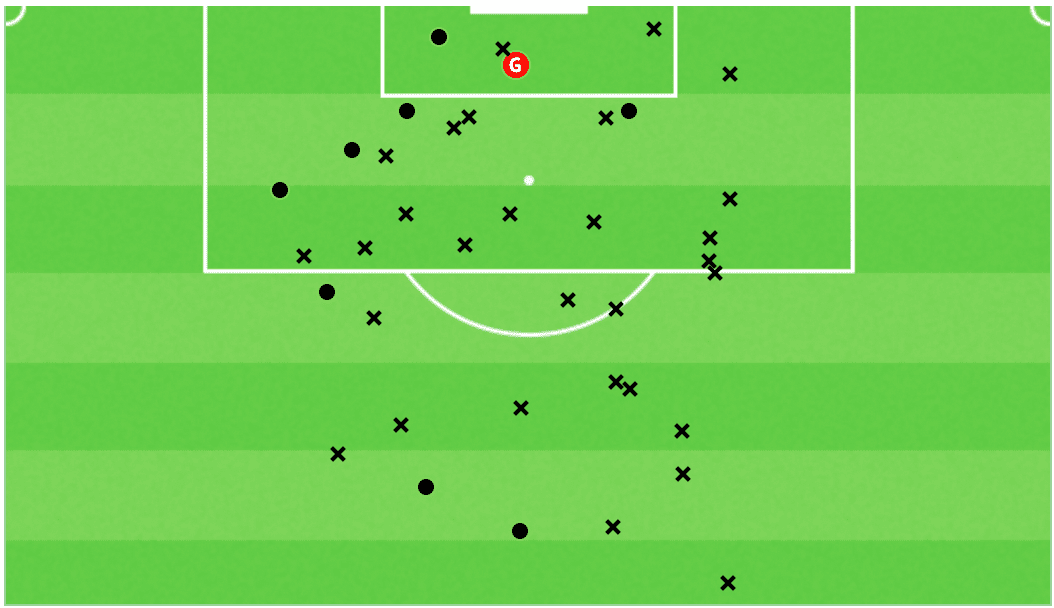
We can see that most of the shots on target conceded by Belgium are located on the right side of their defence. However, right centre-back Amber Tysiak missed some games through injury, meaning the defence was rotated and even included midfielders at centre-back in the latter stages of games, so perhaps this was deliberately targeted by their opposition. A potential weakness to Belgium’s defence that could potentially be targeted at the Euros is their defending at the back post, although their overall aerial duel success is adequate.
Transitions
From their more expansive attacking shape, Belgium requires lots of movement in transitions to get back into their narrow and compact defensive shape. The full-backs available to Serneels seem to have the required recovery pace to track back after advancing to influence attacking play. The holding midfielder is usually the most active in defensive transitions, alongside the ball-side winger and/or player who lost possession.
The holding midfielder is essential to the Red Flames defensively and in transitions. With her movement rarely ahead of the ball, she is often well positioned in rest defence to engage with opposition ball-carriers, whilst occupying spaces to shield the centre-backs. This disciplined positioning out of possession facilitates their ability to cover ground and successfully tackle and outmuscle opposition, qualities that Belgium’s holding midfielder options all possess.
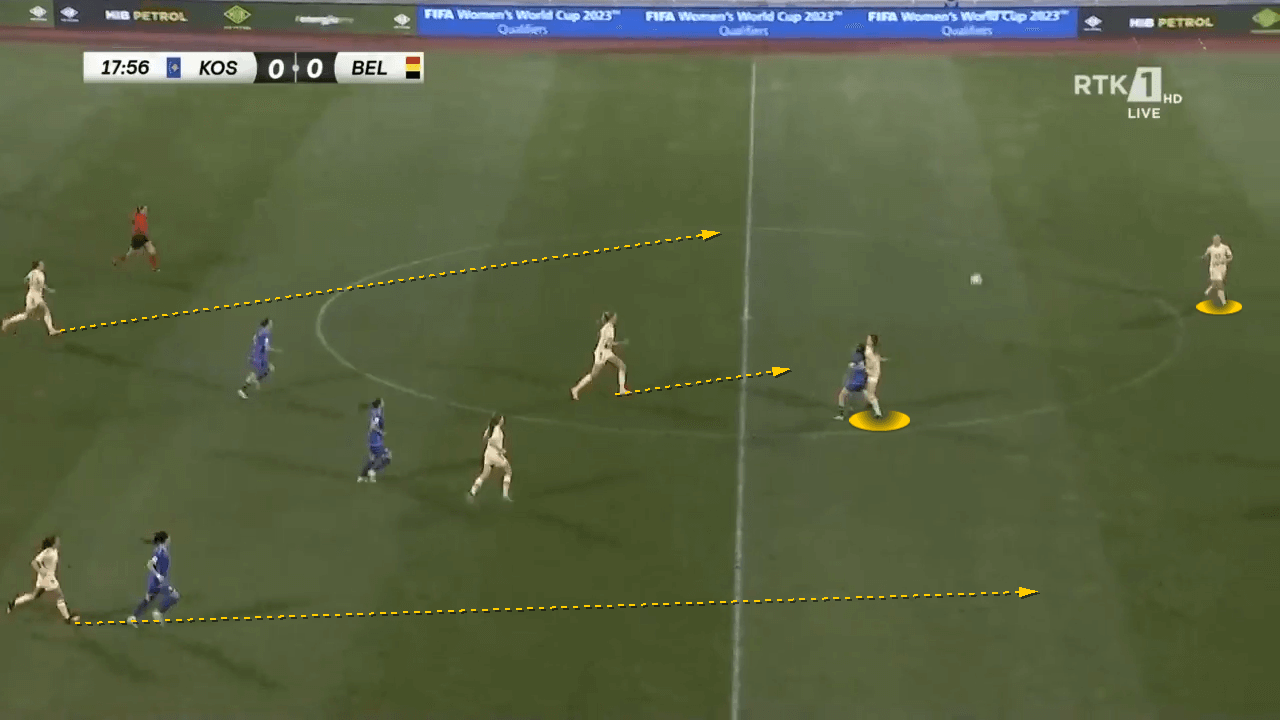
When facing opposition that play with a lone striker, Belgium will sometimes brazenly stick a centre-back on the striker. Man-marking the striker, the centre-back will grab and prevent the striker from turning to chase balls in behind. Blocking their run, the other centre-back can sweep behind so Belgium can regain possession from defensive transitions.
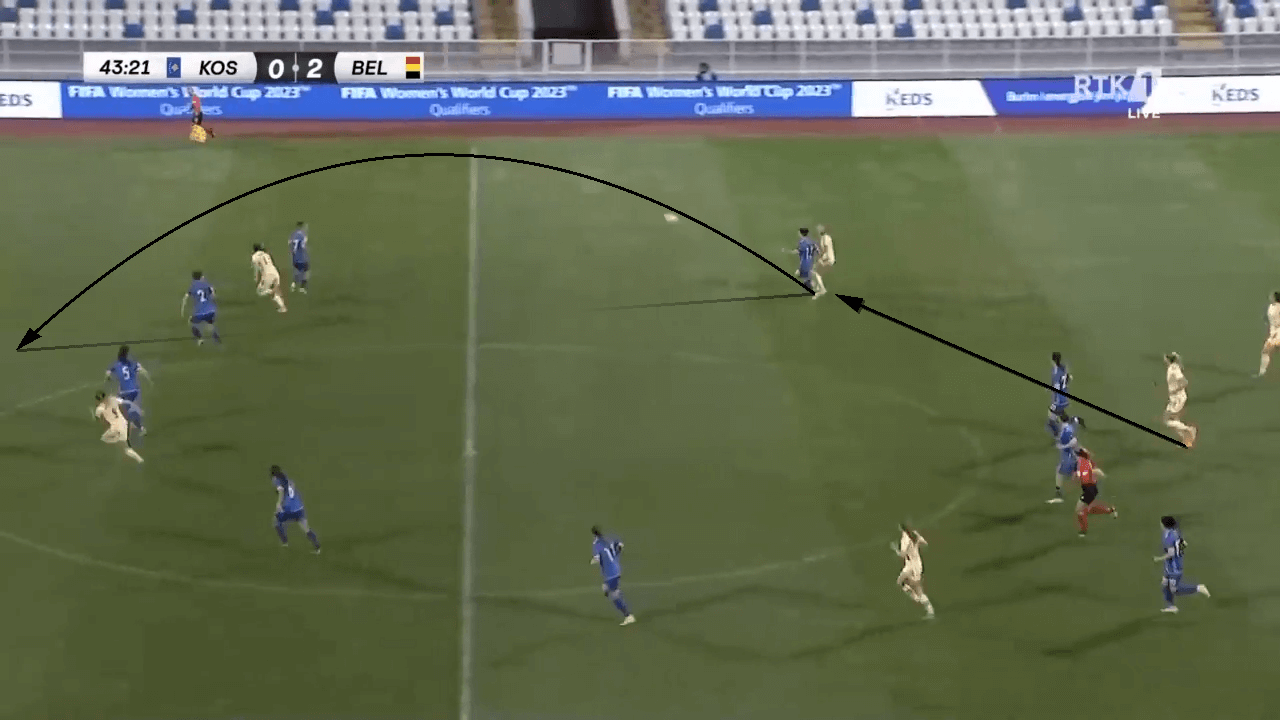
Due to their narrow out-of-possession shape, Belgium’s direct counter-attacks tend to be central; the Red Flames will typically attempt to pass up towards the striker within two passes of the regain.
Depending on location, this pass could be a short pass over five yards, a longer pass to feet for the striker to hold up or turn and attack, or a ball in behind the opposition defence to flip them. However, after regaining possession in their defensive third, Belgium are comfortable enough to retain and build from the back to progress.
Forwards
As mentioned earlier, Wullaert and Eurlings are expected to be Belgium’s starting strike partnership. However, Serneels does have options beyond those two, with Tenerife’s Jassina Blom and Anderlecht’s Ella Van Kerkhoven providing proven ability to score goals when entrusted with doing so, whether that be starting centrally or out wide. Also selected in the provisional squad are younger options alongside Eurlings (19 years old), with Davinia Vanmechelen, Jarne Teulings, and Jill Janssens all under 23 years old and capable of playing in midfield.
Midfielders
With Belgium’s versatility, midfield is an area with depth. Biesmans, Vanhaevermaet, and Onzia have been discussed as options already, but Anderlecht’s Marie Minnaert provides a riskier option in possession — she’s always looking forwards to break lines through dribbling or passing. The rest of their options have struggled for minutes recently due to such tough competition for places, with younger players from OH Leuven like Marie Detruyer and Zenia Mertens battling with Kassandra Missipo, Chloe Vande Velde, and Charlotte Tison, who are regularly called up to squads.
Defenders
In defence, we expect a starting back four of Deloose, Tysiak, De Neve, and Philtjens. These are the four most capped defenders called up by Serneels in Belgium’s provisional squad, but they provide more than just experience. With a suitable centre-back balance of progressive actions in possession and ability to regain when out of possession, full-back Deloose gives a ball-carrying option. Isabelle Iliano will be back-up to left-back Philtjens, with Sari Kees, Shari Van Belle, and Jody Vangheluwe also back-up options selected in the provisional squad.
Best Performer
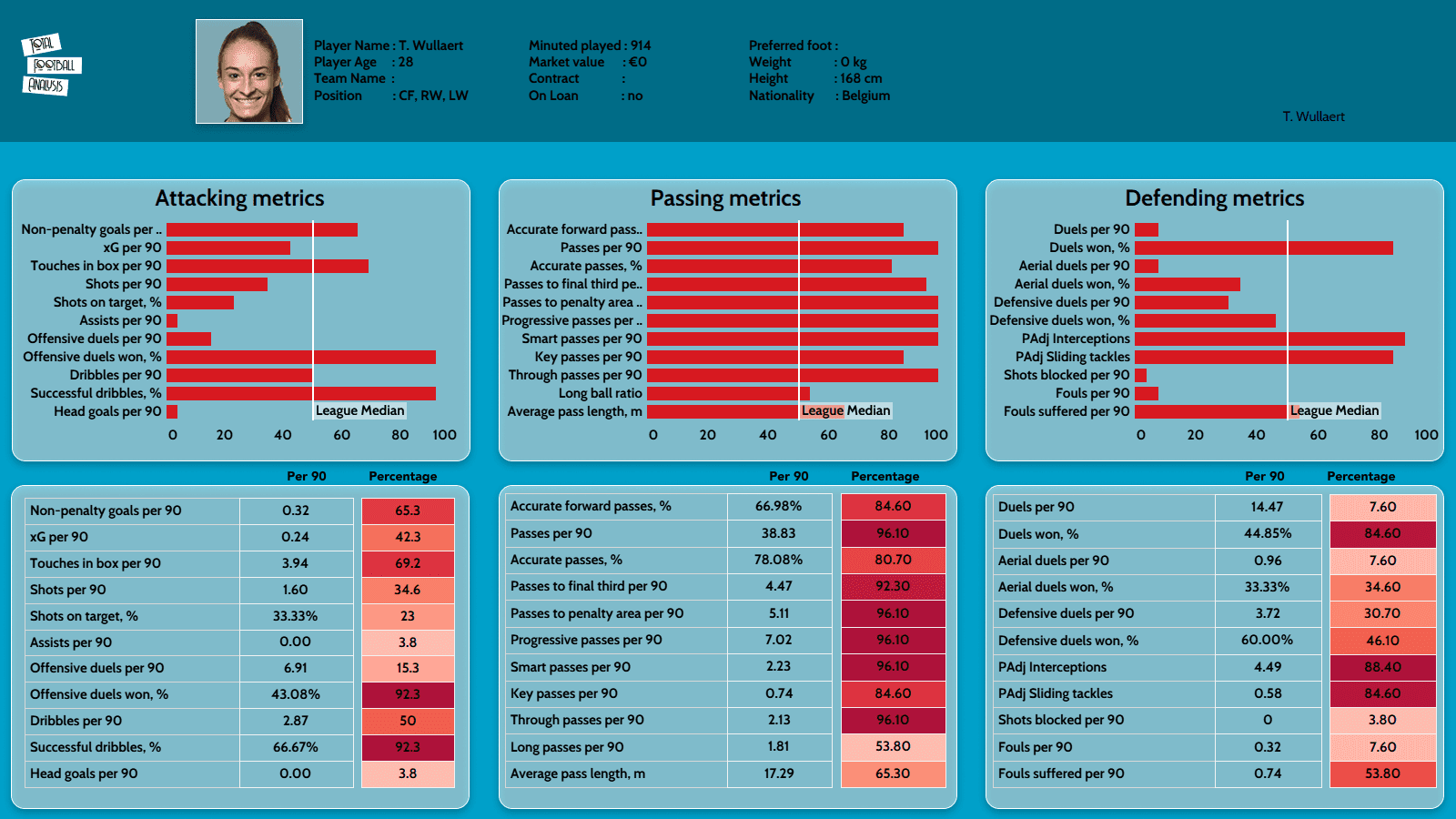
The image here breaks down her domestic performances for the last calendar year and compares her statistics in each noted area with the league median. Notching up 15 goals and 10 assists for Belgium this season, Tessa Wullaert is remarkably averaging a goal involvement every 30 minutes. Essential to the Red Flames’ attacking play, she is the best finisher and creator in the squad and will be vital to Belgium’s attempts of getting out of the group stage.
Wullaert is right-footed but tends to occupy positions in the left half-space. Mainly starting as the left-sided striker, she has also been deployed on the left wing and on the left of a central midfield three. Wullaert is clinical in front of goal and aims to get into one-on-one situations with runs in behind the last defender. Able to time these runs correctly, she is composed under pressure and can convert these chances off both feet with clean technique. Wullaert is also alert to any potential opposition mistakes, with ability to remain focused as she unexpectedly regains possession and punishes the opponent’s error. As a creator, Wullaert has a fruitful partnership with Tine De Caigny — she’s often looking to find the Hoffenheim attacking midfielder. Drifting into wide positions, Wullaert can accurately deliver lofted crosses and low cut-backs towards De Caigny, who usually times her run into the box expertly. When operating in central areas, she can combine with De Caigny with one-twos, and she’s able to resist opposition pressure with her back to goal.
Tournament Prediction
Belgium, as the lowest-ranked nation in their group, will be hopeful of causing an upset to progress into the knockout stages. With their opening game against Iceland, there’s an opportunity for the Red Flames to pick up three points and suddenly change their projection in this group. France, who are ranked 3rd in the world, have the quality to beat any nation and would be expected to overcome the Belgian threat. Their last group game against Italy could potentially be a group decider if Belgium can secure points in one or both of their first two fixtures. If Serneels’ team can unexpectedly progress into the knockout stages, they would likely lose to Group C’s Sweden or Netherlands, who are ranked 2nd and 5th in the world respectively, but this would still be a great achievement for the Red Flames in only their second European Championship.
This Belgium side has the potential to be really entertaining and if Serneels deploys his bold approach by committing players into the forward line, the Red Flames will have the quality and capacity to cause any opponent trouble. However, this can leave them exposed defensively, especially against such quality opponents. Although this will be entertaining for the neutrals and allow Belgium to cause upsets, it would not be surprising to see Serneels alter his style into something that looks to provide a bit more solidity, initially.





Comments